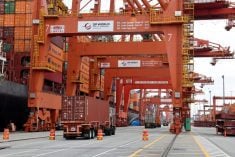By Rod Nickel
June 27 (Reuters) – Canadian farmers planted less wheat than expected and slightly more canola this year, according to a Statistics Canada report on Friday, but the estimates don’t reflect late-seeding problems in soggy parts of the Prairies.
Statscan’s estimates are likely too high because the agency’s farmer survey ended June 10, when some farmers were still struggling to plant fields, said Brian Wittal, analyst at Pro Com Marketing. The estimates don’t fully reflect areas of Manitoba and Saskatchewan that were too wet to plant, he said.
Read Also

Canadian trade data delayed by U.S. government shutdown
Canadian international trade data for September will be delayed indefinitely due to the ongoing partial shutdown of the United States government, Statistics Canada said Friday, Oct. 24.
“I don’t think the reality is that the guys were able to get everything (seeded) that they were planning on, that’s for sure,” Wittal said.
Statscan pegged the all-wheat area at 24.1 million acres, down 2.7 percent from its April planting-intentions estimate and lower than the average trade expectation of 24.5 million acres.
Year over year, all-wheat plantings dipped 7.4 percent.
Canola plantings were estimated at 20.2 million acres, up 2.2 percent from Statscan’s previous estimate, and slightly exceeding the average trade guess of 19.9 million acres. They were 1.5 percent higher than last year’s plantings.
Statscan estimated summer fallow acres – land that was not planted either intentionally or because of bad weather – at 3.45 million acres, down 11 percent from last year.
It’s likely that an additional 1.5 million to 2 million acres were left unseeded, said Jonathon Driedger, market analyst at FarmLink Marketing Solutions, speaking on a conference call organized by Minneapolis Grain Exchange.
The ICE Canada November canola futures contract showed little initial reaction to the report before rising later in the session. Minneapolis September spring wheat futures rose slightly.
The report isn’t likely to sway cash or futures prices much because the numbers aren’t surprising and the trade knows they don’t account for late seeding problems, Driedger said.
The grain industry’s focus now is on weather during the coming weeks. Some areas, including southwestern Alberta, have too much moisture, causing stress to young plants, Wittal said.
Canada is usually the world’s second- or third-largest wheat exporter and the biggest shipper of canola, a cousin of rapeseed used largely to produce vegetable oil.
Statscan estimated drops in plantings of barley (-14 percent), corn (-15.5 percent), durum (-3.3 percent) and oats (-3.8 percent). Plantings of soybeans, a popular crop in eastern provinces that is expanding westward, jumped 23.5 percent to a record 5.6 million acres.














